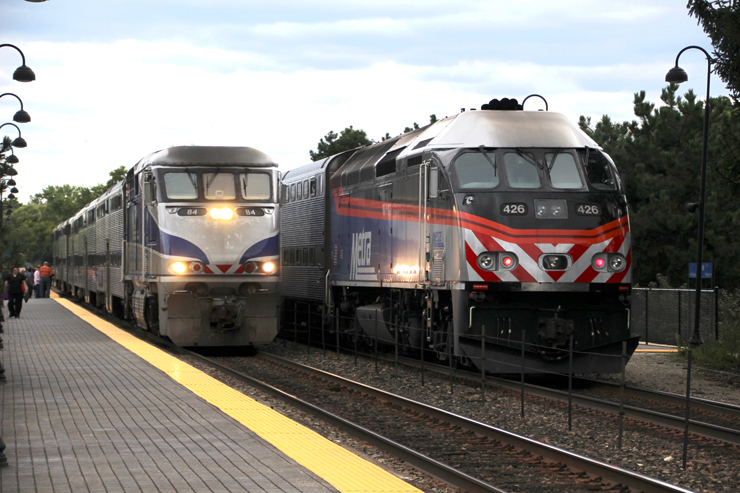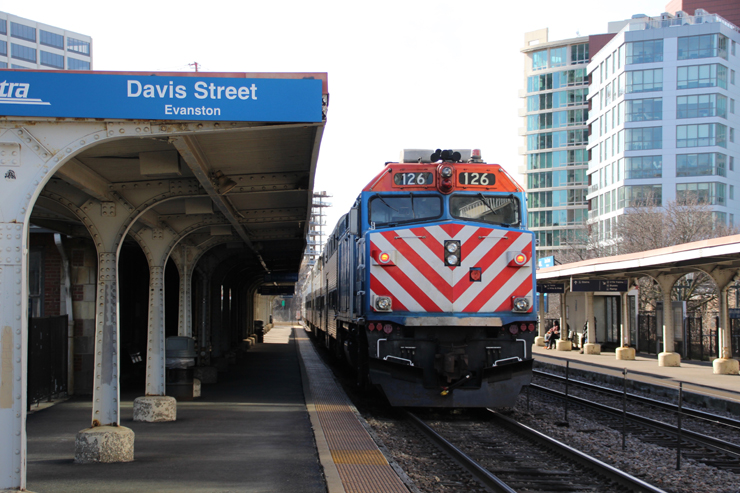CHICAGO — Metra plans “major investments” in locomotives, railcars, and infrastructure, but is not asking for a fare increase, as part of its 2020 budget unveiled at Tuesday’s board of directors meeting.
The commuter railroad is proposing a capital budget of $480.5 million, a figure bolstered by a state program which is projected to provide Metra with more than $1.4 billion over the next five years. [See “Metra eyes $1.6 billion from Illinois capital program,” Trains News Wire, June 13, 2019.] Included in that budget are:
— $138.8 million for new locomotives and railcars. Metra is planning to buy some remanufactured locomotives [see “Metra board approves locomotive purchase; SD70MACH models to come out of EMD,” Trains News Wire, Feb. 20, 2019], has set aside funds for a prototype alternative fuel locomotive, and has a request for proposals pending for up to 400 new passenger cars. [See “Metra to re-issue RFP for new railcars,” Trains News Wire, July 18, 2018.]
— $95.3 million for locomotive and car rehabilitation. In addition to continuing the rehabilitation of locomotives and cars Metra is performing at its 47th Street shops, this will fund overhaul of 21 recently purchased former Amtrak locomotives and installation of more reliable AC traction motors on 54 locomotives
— $51.2 million for stations and parking. This will include the Auburn Woods station on the Rock Island line which recently celebrated its groundbreaking [see “Metra marks groundbreaking for New Chicago station,” Trains News Wire, Oct. 1, 2019 ]; upgrades of two stations at on the Metra Electric line and the Evanston-Davis Street station on the UP North; and ongoing efforts to improve ADA accessibility and make sure every station has a warming shed.
— $23.2 million for expanding two adjacent yards: the Western Avenue yard serving Milwaukee, North Central, and Heritage Corridor equipment, and the California Avenue yard for Union Pacific line trains.
— $22.6 million for bridges, allowing Metra to replace several bridges among the nearly 500 on its lines that are more than a century old.
Metra’s $827.4 million operating budget is a $5 million increase over 2019. It avoids a fare increase in part by saving $18 million through what the railroad calls “efficiencies” in a press release, as well as through reduction of overtime and by not filling some vacancies. That will help offset anticipated increased expenses related to positive train control ($7 million) and labor and other expenses ($16 million).
The complete budget proposal is available at Metra’s website, as is a list of sites of public hearings on the budget to be held Nov. 4-5.
















The Metra Davis-Street Evanston station main (station) building is over 100 years old (opened in 1911?) and so is no doubt need of some rehabilitation. Will Metra ever restore the third track on the C&NW North Line that was removed back in 1984? This would no doubt be a costly capital project.
Funny, one thinks of the MP-36PH passenger locomotives as being fairly new, but they were delivered back in 2003 – 2004 and so indeed are due for a mid-life “overhaul.”
@John Rice: Wabtec does market the MP54AC variant of their MPXpress line. Ergo, the equipment is “off-the-shelf” for a DC to AC conversion of the MP36. Maybe they’re thinking that can be adapted to an F59? In any case it won’t be cheap.
@Daniel Carleton: This is throwing me off as well. I found this remark,
“McCann said a significant benefit from the purchase will be evident in the locomotives’ traction motors, which deliver the power generated by the diesel engine to the wheels. The remanufactured locomotives will have AC traction motors, which are far more durable and reliable than the DC traction motors in Metra’s older locomotives.
For example, Metra currently needs to replace about 160 DC traction motors annually. On Metra Electric cars, the oldest of which have had AC traction motors for 12 years, Metra has not had to change a single traction motor.
The remanufactured locomotives have a similar design to Metra’s F59 locomotives so Metra will be able to use the same parts inventory and won’t need different training and maintenance programs, McCann said.”
This sounds like the F59PHI that already has HEP but remanufactured with AC traction motors.
“[I]nstalation of more reliable AC traction motors on 54 locomotives.” Huh?
@John Rice: There’s much more to it than that and it sounds like they are talking about converting 54 legacy locos to AC traction which is no small feat.
D.Carleton
SMI Master Mechanic
WPB, FL
@Daniel Carleton: DC motors don’t hold up as well to the road salt and cold weather as the AC motors do.
The Fox River Bridge is a major bridge expansion. I believe the “bridges” referred to in this post mostly are century old street viaducts on elevated ROWs in the City of Chicago. This work had already been completed on certain stretches (UP Northwest Line, the RI along the Dan Ryan, and is ongoing for the UP North Line) but there’s plenty more and these funds might allow replacement of a few more (on the BNSF or MILW lines for example).
Is there anything in here about upgrading the pathetic terminal at LaSalle Street?
I think the bridge-replacement program is ongoing, as they strive to replace bridges on the UP North and Northwest lines (so they can handle something heavier than an F40PH). I’m assuming that the new span over the Fox River at Geneva (for the third track) has already been budgeted.
JOHN RICE — I love visiting Chicago and other parts of Illinois but I hope they go broke. They deserve it. A city and state that had so much going for them is mismanaged and well on their way to bankruptcy. No one’s fault but their own.
Long over due yet they should have budgeted more for bridges in my opinion. It was just $34 million to replace the Fox River Bridge.
All of this investment courtesy of the State of Illinois passing a doubling of the motor fuels tax.
So while a fare increase is not required, the residents of Illinois are still paying.
The only saving grace and the reason they can dedicate the money is that Illinois voters passed a constitutional amendment that forces tax revenue for transportation to be used *only* for transportation. It can no longer be siphoned off to prop up the general fund or used as collateral for yet another refinancing of the state budget.
So the politicos took the voters up on that amendment and doubled the fuel tax.
Technically its all for naught.
Illinois has already doubled the income tax. Chicago transit already collects a sales tax in their service area.
Illinois has raised the property tax rates to the point its causing home values to decline and forcing industry and jobs to move out. Essentially Illinois took out a pay day loan to pay public service unions and pensions and is using their ability to raise property taxes as a sort of home equity loan against homeowners. The burden is causing problems as people can no longer sell their homes at market rates. When prospective buyers see how much of a chunk of their escrow goes to paying the state coffers, they promptly reduce their offers to compensate.
The result is Illinois has had a net loss in population for several years and the rate of loss is growing. Last year it was about 20,000 people a year, now they forecast it will start getting closer to 30,000 a year in 2021.
That is a lot of revenue leaving the state for good.